Texture squick
This is kind of random, but I have wanted for years to make a post about trypophobia, which is something I experience. I don't particularly like the name trypophobia ("fear of holes"), though, because it's not exactly a phobia, nor is it limited to holes. So instead I'm going to call it "texture squick," which I think more accurately captures the experience.
Just a heads up that the first part of this post features a lot of detailed description of creepy things that might make you uncomfortable (certainly made me uncomfortable writing them), and the second part of this post features a lot of images which will be highly unpleasant if you have texture squick (but probably look perfectly innocuous if you don't).
Anyway, there are several issues I have with the way trypophobia is described on the internet, so I wanted to clear them up.
First, the kinds of things that trigger texture squick don't just include holes but rather are a wide variety of "creepy textures." For me, I experience a lot of textures as creepy including holes, circles with defined edges (which maybe look like holes?), bumps (which of course could be identical to holes if you make different assumptions about lighting), irregular squiggles, clusters of bubbles, and so on. Unfortunately, many examples that people post of trypophobic textures focus overwhelmingly on holes, which doesn't feel right to me.
Second, the emotion that is experienced in reaction to these kinds of stimuli isn't anxiety or panic or fear, but rather a feeling of disgust, a "creepy crawly" feeling, "heebie-jeebies," a shudder, an unsettled/unnerved sort of feeling, or even at the extreme end, a feeling of anger or hatred.
Finally, the examples that people produce for trypophobic imagery are often incredibly extreme examples that seem designed to trigger feelings of disgust/discomfort/creeped-out-ness in the whole population, i.e. people who do not have trypophobia. For example, I remember one of the common examples of trypophobia triggers used to be the common Suriname frog, a frog that gives birth out of holes in its back. The examples would often be full motion video clips that show the baby frogs emerging out of the network of holes. While this is certainly an example that triggers my texture squick, there are several problems with using this as an example. First of all, texture squick happens for stationary textures, so there is no reason to need motion sequences to trigger it, so why are they being used in this example? Second, this example conflates two separate "creeped-out-feeling" triggers: textures and body horror. Body horror is where aberrations or abnormalities in the way a normal, healthy body looks or behaves yields an unsettled feeling, which is absolutely at play in an example where a frog is birthing baby frogs out of burrows carved into its own back. As body horror is a much more common squick found in the general population, this is what I mean when I say that trypophobia examples often seem designed to trigger emotions in non-trypophobic people, which defeats the purpose of using them.
Another common trypophobic trigger example is the lotus seed pod, which IS a stationary picture but one that resembles or recalls the Suriname frog example because lotus seed pods very much also look like an alien organism trying to forcibly break through the surface of a second organism, which is going to trigger the same body horror feelings. Other common examples feature photoshopping creepy hole textures (which would be creepy even if they were abstract patterns for people with texture squick) onto people's arms or faces. Again, these examples are almost certainly conflating texture squick with body horror in a way that makes detecting actual texture squick impossible. While it's probably true that texture squick is related to/derived from some body horror detector, the thing that makes it odd is that it is overactive -- it reacts even to obviously inert, inanimate objects like still patterns that should not cause a horror reaction.
In any case, the reason why these examples are so extreme is that it's probably an attempt by trypophobic people to try to get non-trypophobic people to understand their emotional reaction, and they are only able to get reactions from normal people when they use these extreme examples. But this doesn't really help in understanding the actual phenomenon of trypophobia.
The Wikipedia article on trypophobia actually has a pretty good/accurate description of the kinds of things that trigger this squick reaction, how the reaction feels, and also contains a critique of how many examples of trypophobic stimuli found on the internet are highly questionable, which are all points I think are good to make.
Anyway, the rest of this post will be my attempt to give examples of things that trigger my texture squick and to explain the qualities of the texture that is making it creepy for me. For the past few years I've been collecting photos of creepy textures for this purpose, and I'm sorting them roughly from weakest to strongest.
For these photos, when I look at them later, the disgust reaction is much more muted than it was when I took the photo. When I show these to my dad and my sister (who also experience texture squick), they similarly have muted or no reactions. (My sister and I have known we both have texture squick for most of our lives because we talk about that stuff frequently. But weirdly, I only recently found out my dad also experiences it, making me wonder if it's genetic. My brother says he can kind of see the creepiness of certain textures, but I basically think he does not have a texture squick.)
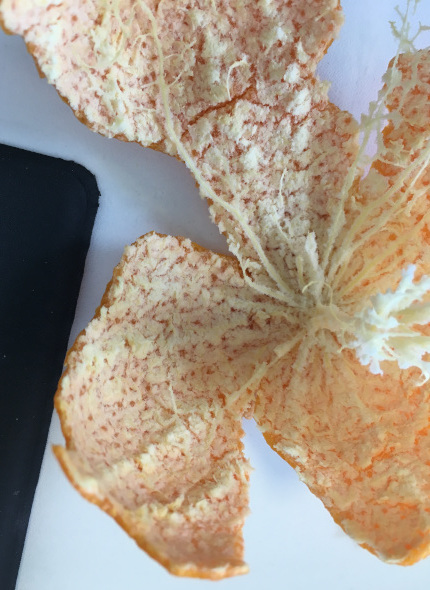
A picture of the rind of an orange. This one was more intense when I was experiencing it firsthand, but now it is barely noticeable what textures in the picture are objectionable, I think because the colors here are so low-contrast. However, I have tried to highlight the possibly creepy textures:

These patterns featuring a relatively dark circle surrounded by a lighter irregular shape is what creeped me out (this is the "cell-like" pattern I talk about later). The long white tendrils do not strike me as creepy at all, however.
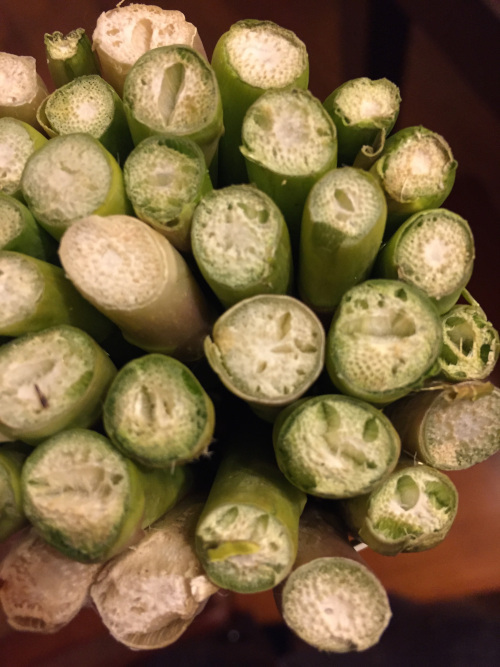
The cross-section of a bunch of asparagus stalks. I took this picture because it creeped me out, but reviewing it again, I experience basically no discomfort (part of that is that the image is kind of blurry, which tends to soften the effect). It might just be that this was the first time cooking with asparagus and I didn't expect their cross-sections to look so irregular like this. The creepy part here is the small bubble texture broken by irregular-sized large holes.

Another very mild example that creeped me out at the time but now gets basically no reaction from me. Despite the fact that this is a classic holey texture, it's not that creepy, possibly because one expects swiss cheese to be holey. But I think at the time, I was creeped out because the holes seemed all concentrated at the lower-left quadrant and I didn't know why.
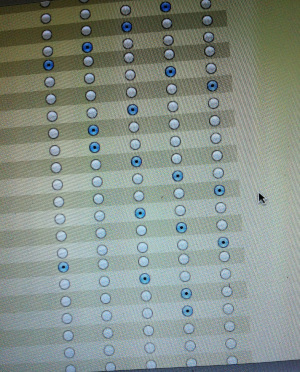
Sorry for the low-quality. I was filling out a personality quiz and my filled-in bubbles started creeping me out, because they were irregularly distributed and also had the "cell-like" pattern (very dark nucleus surrounded by a lighter circle). Now the effect is minimal/very mild.
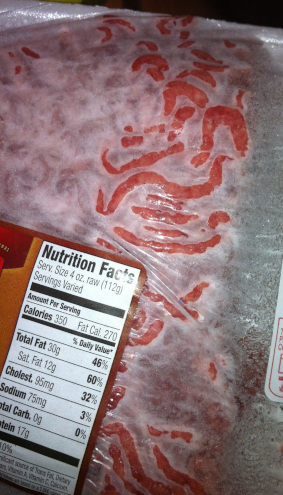
This is a picture of frozen ground beef, where tendrils of the beef touching the cling wrap have high contrast compared to the lower parts. I don't really know now what creeped me out about this. My guess is the smaller shapes toward the upper edge (scale is often important for creepy textures, and the longer lines near the center don't really creep me out at all). This is an example of how some creepy textures are not at all hole-based.

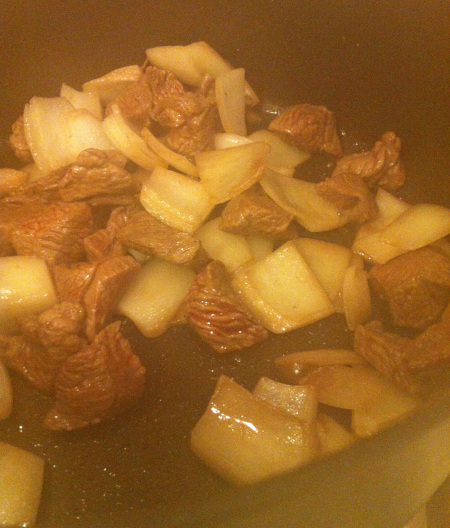
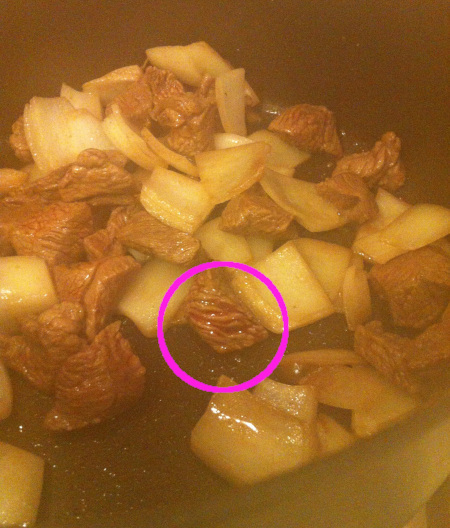
This is a picture of some beef stir-fry I was cooking. This is another good example of how not all creepy textures involve holes. Here, the creepy texture was the irregular lines on the surface of the beef as highlighted in the second image. I'm not usually squeamish about blood, so I think what creeped me out here was the contrast between the light brown (cooked) raised parts and the dark red (uncooked) inner parts that also formed these sharply distinguished irregular shapes.
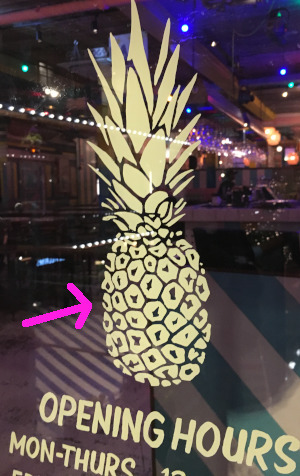
This is a picture of a sticker in the door of a restaurant: a stylized illustration of a pineapple. This is a "cell-like" texture which features a dark nucleus surrounded by lighter color (more examples of this later). Very irregular. At the time, I found this deeply creepy, but upon viewing it later, the effect is only mild.
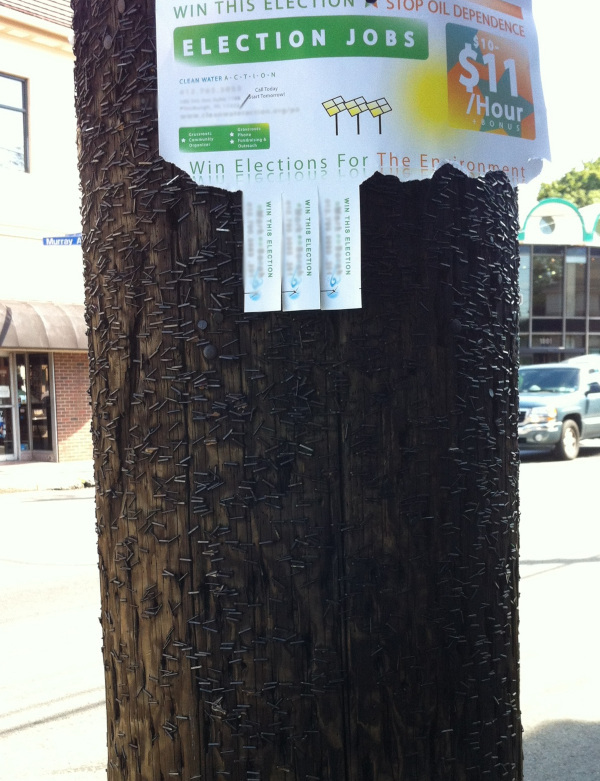
This is a picture of a wooden post/telephone pole thing that people frequently staple fliers to. From a distance, the accumulated staples looks like a bark-like texture not too odd against the wooden pole. However, when I took a closer look, the staples definitely aren't wood and are chaotic and irregular enough that I got unsettled. Looking at the picture again, the creepy effect is minimal, almost non-existent. I think at the time I was creeped out by the density of old staples here. It was surprising, and in this density, they look possibly reminiscent of insects or maggots.

This is a picture of the window of an electric kettle, showing the condensed water droplets. Not as creepy to me as the bubble examples below, but still creepy for the same reasons.
These examples squick me less when I view the photo now than they did when I took them. However, I can still experience a fairly strong disgust reaction even reviewing the photo again. My dad and sister also can kind of see the creepy texture.

This is a picture of some Ethiopian injera (flatbread). The spongy texture makes for a classic "holey" texture. However, the creepiness here is only mild. Possibly it was stronger at the time I took the photo, but reviewing it, it's similar in creepiness to the other examples in this section.
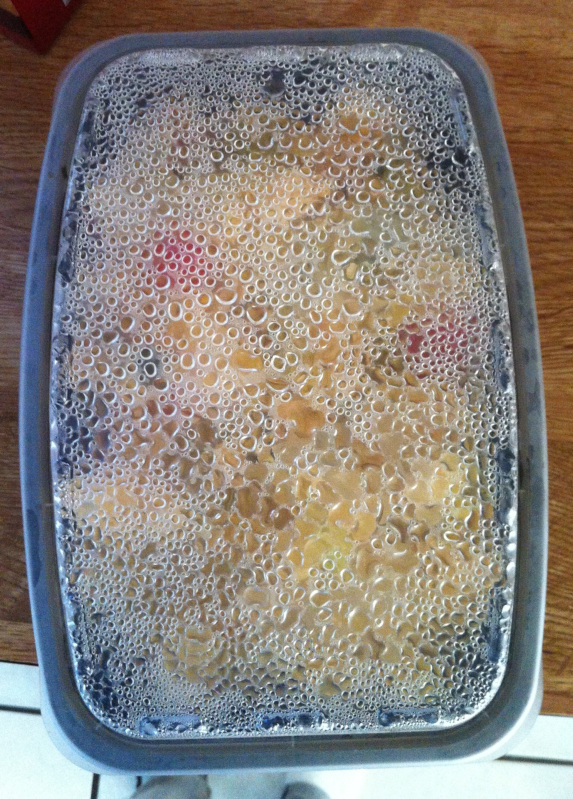
This is a photo of water droplet condensation on the lid of a tupperware. You can see that this is similar to a typical "holey" texture, but it's only mildly creepy to me when I look at it again. The parts that seem the most creepy to me are highlighted in the image below. Scale is kind of important when viewing these textures and the smaller bubbles are worse for me in this particular case. The section highlighted also features quite a bit of irregularity, with the size of the droplets changing a lot. It's possible this texture looks creepy because they look like eyes?

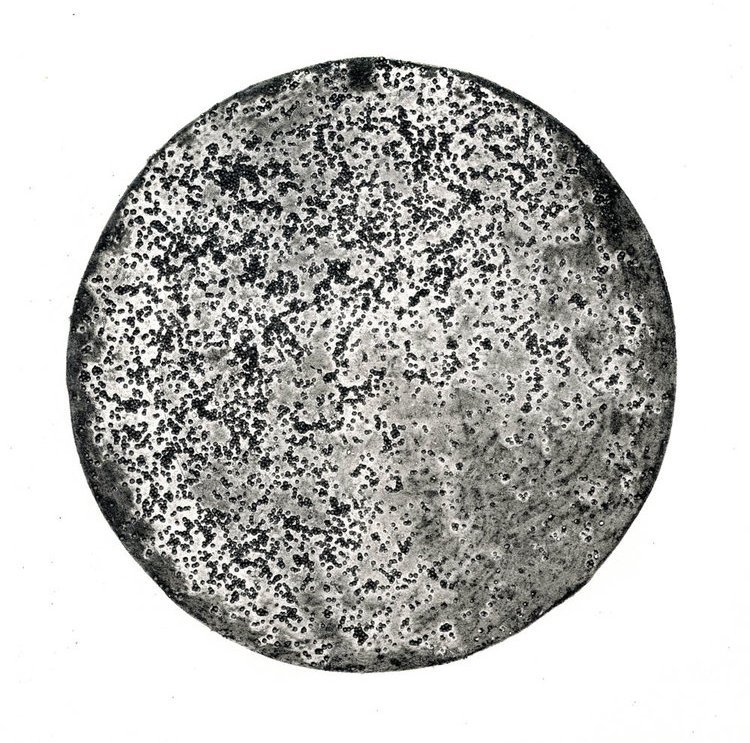
I came across this stylized full moon by an artist called Melody Overstreet. I find the dots/speckles here vaguely creepy. Oddly, the pockmarks and craters of the real full moon do not creep me out at all -- I find them beautiful.

This is a flier hanging in the automatic doors of a grocery store. The irregular sizes of location pushpins here, and the strong black/white contrast make this somewhat creepy to me, even looking at the photo later. The effect to my eyes is quite similar to the previous bubble/droplets example. Makes me think that not everyone has this texture squick because otherwise it would have been too creepy for the designer of this flier to make this image like this.
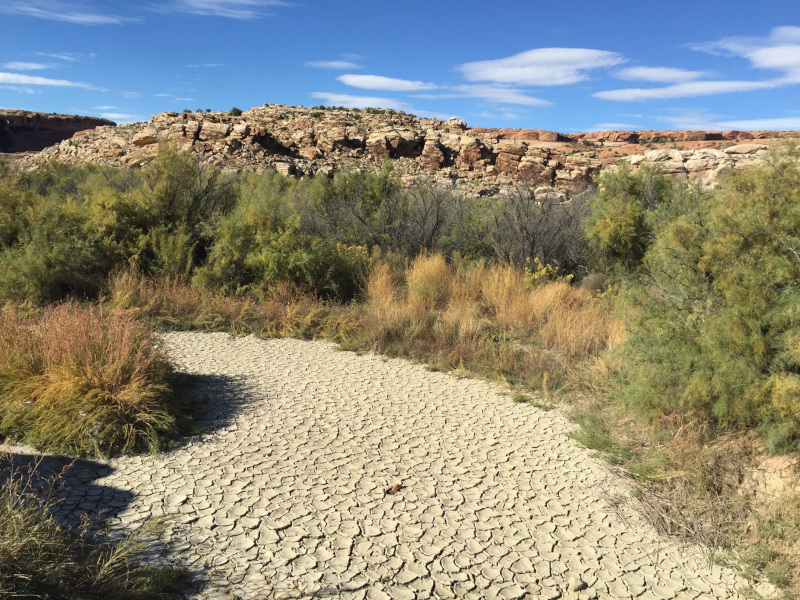
This is a picture of a dried-up streambed in the summer. Scale seems to be important for this one. When I see it zoomed out, it gives me a creepy feeling, but when I look at the full picture, the creepy feeling is minimal. In any case, the texture is irregular and the strong edges/shadows give a very 3-D appearance to the fragments/cracks. It's possible that the reason these crack type patterns creep me out is that they resemble dry/flaky skin.
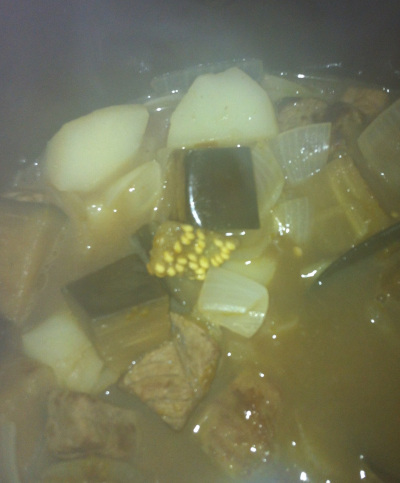
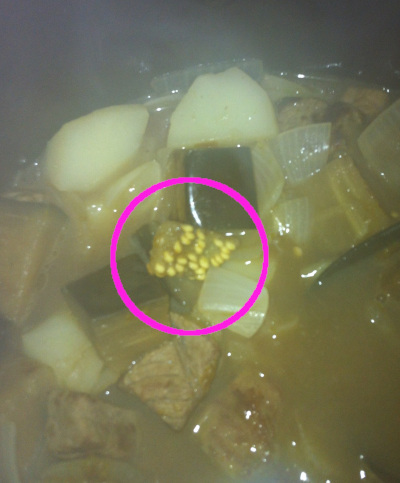
I was using eggplants in a stew and when they started softening, the seeds clustered like this and I did not like it. Possibly the squick reaction was just the result of cooking eggplant for the first time and not realizing they behaved like this. My dad and sister weren't fazed by this one, but this cluster of seeds still kind of creeps me out.

A picture of cucumber makizushi. Yeah, this still creeps me out now. At the time, it mildly creeped me out; the picture retains the same mild creepy intensity. The tightly-clustered, irregularly packed items that leaves some space for holes is possibly what leads to the slightly creepy effect.
These examples strongly creep me out whether I encounter them in real-life or in still picture format. They get an instant "creepy!" from other people in my family.
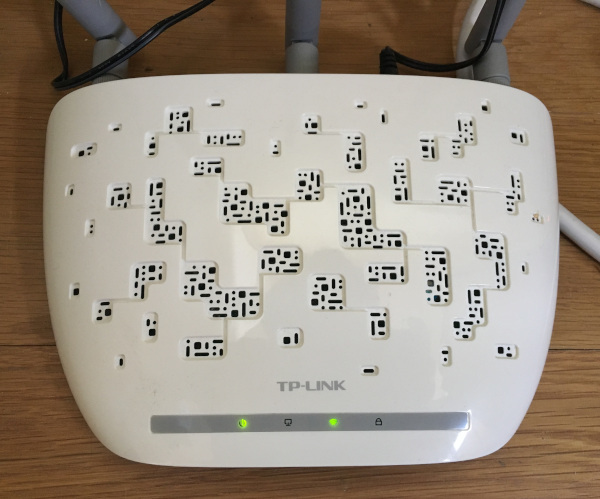
This is a picture of the top of someone else's router. For some reason, the designer thought it would be nice to have the ventilation be in this decorative pattern, but the irregularity of the placement and shape of the holes makes this highly creepy to me.
Biology diagrams (e.g. of cells and parts of the body). It's very difficult for me to look through biology textbooks because they often feature these kinds of diagrams.
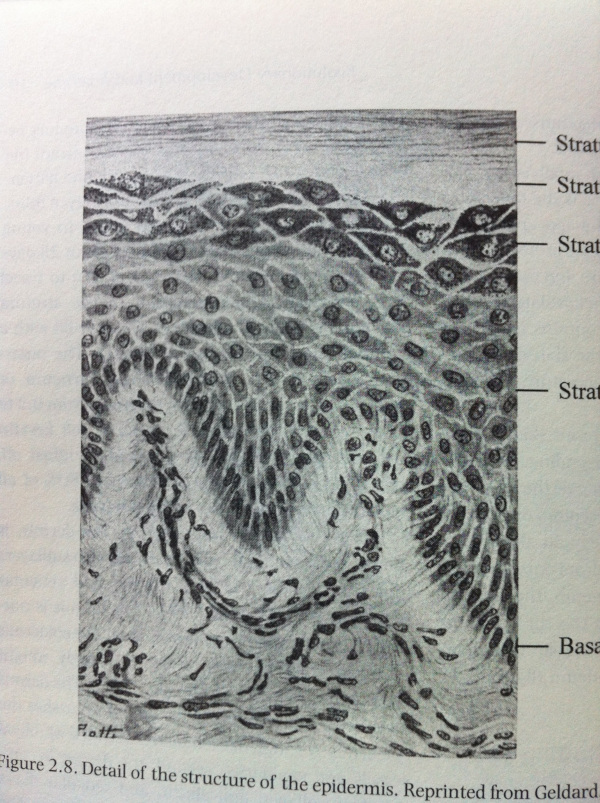
An illustration of layers of the skin. Basically all the textures in this image squick me. The presence of dark circles surrounded by lighter shapes, all of which are irregular creeps me out. The parts at the bottom are the "irregular worm-like pattern" that was the issue in the earlier ground beef example.

A microscopic photo of skin tissue, I think? I find the irregularity in size and placement of the dark circles vaguely unsettling.
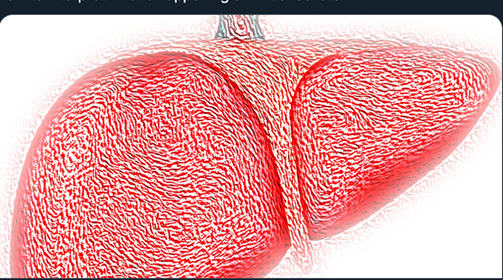
I'm not sure what this is a diagram of, but I hate it. I thought that this might be another "extreme" example of trypophobic imagery that manages to get picked up as creepy even by non-trypophobic people, but my partner tells me he actively likes it (???). The high-contrast, irregular, worm-like shapes is similar to what I didn't like about the beef textures above.
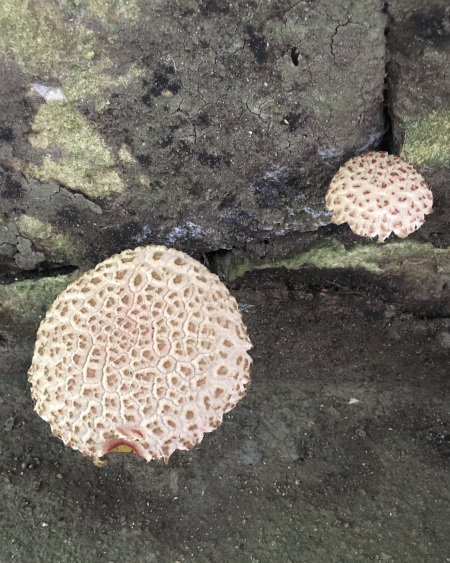
The caps of a couple of mushrooms growing out of a wall. Another cell-like texture, super irregular. I hate this texture. Interestingly, there are a lot of textures in the background (the cracks and bumps of the stone and ground), which I find perfectly fine.

A stone wall I came across while in London. I HATE this texture. Looking at these pictures still gives me the creeps. The irregularity and very defined shadows/edges are probably a large part of this. Again, another example where texture squick extends beyond just holes. The same wall but further away (still very gross):

Coral. Or whatever these things are that are sometimes put in fish tanks.

I found this picture when writing quiz questions. I thought that the blue-ringed octopus (the rings and/or the bumps on its skin) would trigger my texture squick, but nope, I was completely fine. Rather, it's the pockmarked coral(?) on the left that ended up attracting my horrified attention.
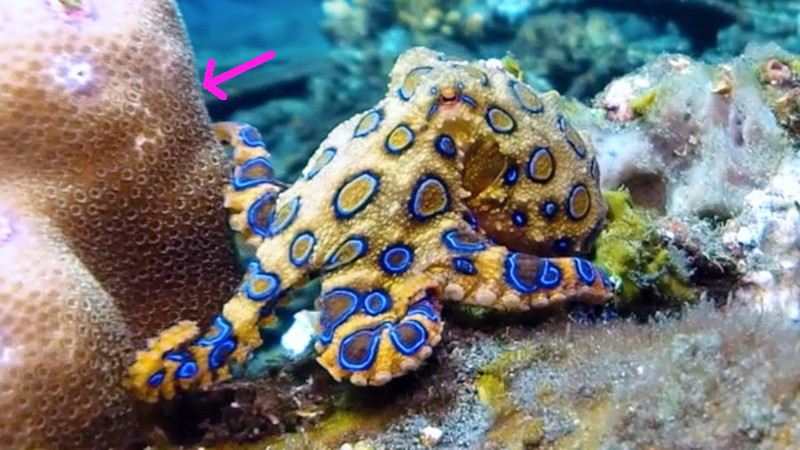
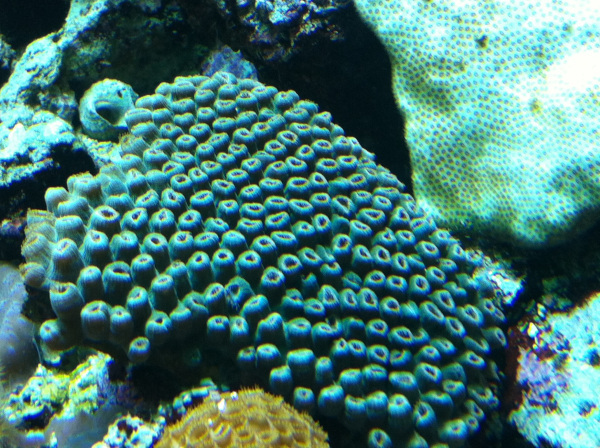
A picture of some coral(?) taken at a local aquarium. I HATE this. There are actually two textures here that creep me out: the main coral and the yellowish irregular dot pattern in the background. Both creep me out. They're both "holey" textures. Note that highly regular dot patterns like polka dots do not creep me out.

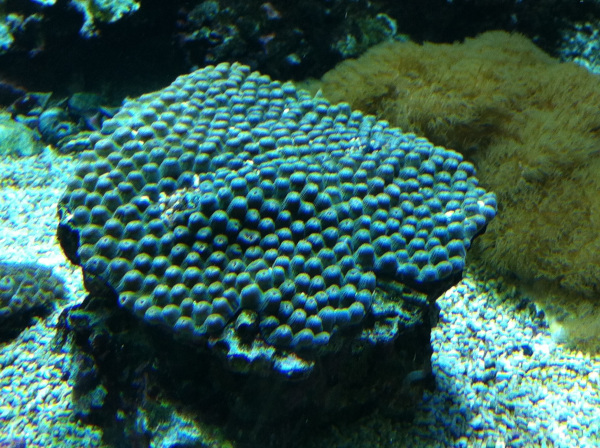
Another example where the texture is mainly bumps and less holes. Still creepy and unsettling, but maybe a bit less than the above examples?
I hope this is a good resource for describing texture squick to people who do/don't have it. And now that I've finished this post, I will never click on this cut again, lol.
Just a heads up that the first part of this post features a lot of detailed description of creepy things that might make you uncomfortable (certainly made me uncomfortable writing them), and the second part of this post features a lot of images which will be highly unpleasant if you have texture squick (but probably look perfectly innocuous if you don't).
Anyway, there are several issues I have with the way trypophobia is described on the internet, so I wanted to clear them up.
First, the kinds of things that trigger texture squick don't just include holes but rather are a wide variety of "creepy textures." For me, I experience a lot of textures as creepy including holes, circles with defined edges (which maybe look like holes?), bumps (which of course could be identical to holes if you make different assumptions about lighting), irregular squiggles, clusters of bubbles, and so on. Unfortunately, many examples that people post of trypophobic textures focus overwhelmingly on holes, which doesn't feel right to me.
Second, the emotion that is experienced in reaction to these kinds of stimuli isn't anxiety or panic or fear, but rather a feeling of disgust, a "creepy crawly" feeling, "heebie-jeebies," a shudder, an unsettled/unnerved sort of feeling, or even at the extreme end, a feeling of anger or hatred.
Finally, the examples that people produce for trypophobic imagery are often incredibly extreme examples that seem designed to trigger feelings of disgust/discomfort/creeped-out-ness in the whole population, i.e. people who do not have trypophobia. For example, I remember one of the common examples of trypophobia triggers used to be the common Suriname frog, a frog that gives birth out of holes in its back. The examples would often be full motion video clips that show the baby frogs emerging out of the network of holes. While this is certainly an example that triggers my texture squick, there are several problems with using this as an example. First of all, texture squick happens for stationary textures, so there is no reason to need motion sequences to trigger it, so why are they being used in this example? Second, this example conflates two separate "creeped-out-feeling" triggers: textures and body horror. Body horror is where aberrations or abnormalities in the way a normal, healthy body looks or behaves yields an unsettled feeling, which is absolutely at play in an example where a frog is birthing baby frogs out of burrows carved into its own back. As body horror is a much more common squick found in the general population, this is what I mean when I say that trypophobia examples often seem designed to trigger emotions in non-trypophobic people, which defeats the purpose of using them.
Another common trypophobic trigger example is the lotus seed pod, which IS a stationary picture but one that resembles or recalls the Suriname frog example because lotus seed pods very much also look like an alien organism trying to forcibly break through the surface of a second organism, which is going to trigger the same body horror feelings. Other common examples feature photoshopping creepy hole textures (which would be creepy even if they were abstract patterns for people with texture squick) onto people's arms or faces. Again, these examples are almost certainly conflating texture squick with body horror in a way that makes detecting actual texture squick impossible. While it's probably true that texture squick is related to/derived from some body horror detector, the thing that makes it odd is that it is overactive -- it reacts even to obviously inert, inanimate objects like still patterns that should not cause a horror reaction.
In any case, the reason why these examples are so extreme is that it's probably an attempt by trypophobic people to try to get non-trypophobic people to understand their emotional reaction, and they are only able to get reactions from normal people when they use these extreme examples. But this doesn't really help in understanding the actual phenomenon of trypophobia.
The Wikipedia article on trypophobia actually has a pretty good/accurate description of the kinds of things that trigger this squick reaction, how the reaction feels, and also contains a critique of how many examples of trypophobic stimuli found on the internet are highly questionable, which are all points I think are good to make.
Anyway, the rest of this post will be my attempt to give examples of things that trigger my texture squick and to explain the qualities of the texture that is making it creepy for me. For the past few years I've been collecting photos of creepy textures for this purpose, and I'm sorting them roughly from weakest to strongest.
Weakest
For these photos, when I look at them later, the disgust reaction is much more muted than it was when I took the photo. When I show these to my dad and my sister (who also experience texture squick), they similarly have muted or no reactions. (My sister and I have known we both have texture squick for most of our lives because we talk about that stuff frequently. But weirdly, I only recently found out my dad also experiences it, making me wonder if it's genetic. My brother says he can kind of see the creepiness of certain textures, but I basically think he does not have a texture squick.)

A picture of the rind of an orange. This one was more intense when I was experiencing it firsthand, but now it is barely noticeable what textures in the picture are objectionable, I think because the colors here are so low-contrast. However, I have tried to highlight the possibly creepy textures:

These patterns featuring a relatively dark circle surrounded by a lighter irregular shape is what creeped me out (this is the "cell-like" pattern I talk about later). The long white tendrils do not strike me as creepy at all, however.

The cross-section of a bunch of asparagus stalks. I took this picture because it creeped me out, but reviewing it again, I experience basically no discomfort (part of that is that the image is kind of blurry, which tends to soften the effect). It might just be that this was the first time cooking with asparagus and I didn't expect their cross-sections to look so irregular like this. The creepy part here is the small bubble texture broken by irregular-sized large holes.

Another very mild example that creeped me out at the time but now gets basically no reaction from me. Despite the fact that this is a classic holey texture, it's not that creepy, possibly because one expects swiss cheese to be holey. But I think at the time, I was creeped out because the holes seemed all concentrated at the lower-left quadrant and I didn't know why.

Sorry for the low-quality. I was filling out a personality quiz and my filled-in bubbles started creeping me out, because they were irregularly distributed and also had the "cell-like" pattern (very dark nucleus surrounded by a lighter circle). Now the effect is minimal/very mild.

This is a picture of frozen ground beef, where tendrils of the beef touching the cling wrap have high contrast compared to the lower parts. I don't really know now what creeped me out about this. My guess is the smaller shapes toward the upper edge (scale is often important for creepy textures, and the longer lines near the center don't really creep me out at all). This is an example of how some creepy textures are not at all hole-based.



This is a picture of some beef stir-fry I was cooking. This is another good example of how not all creepy textures involve holes. Here, the creepy texture was the irregular lines on the surface of the beef as highlighted in the second image. I'm not usually squeamish about blood, so I think what creeped me out here was the contrast between the light brown (cooked) raised parts and the dark red (uncooked) inner parts that also formed these sharply distinguished irregular shapes.

This is a picture of a sticker in the door of a restaurant: a stylized illustration of a pineapple. This is a "cell-like" texture which features a dark nucleus surrounded by lighter color (more examples of this later). Very irregular. At the time, I found this deeply creepy, but upon viewing it later, the effect is only mild.

This is a picture of a wooden post/telephone pole thing that people frequently staple fliers to. From a distance, the accumulated staples looks like a bark-like texture not too odd against the wooden pole. However, when I took a closer look, the staples definitely aren't wood and are chaotic and irregular enough that I got unsettled. Looking at the picture again, the creepy effect is minimal, almost non-existent. I think at the time I was creeped out by the density of old staples here. It was surprising, and in this density, they look possibly reminiscent of insects or maggots.

This is a picture of the window of an electric kettle, showing the condensed water droplets. Not as creepy to me as the bubble examples below, but still creepy for the same reasons.
Moderate
These examples squick me less when I view the photo now than they did when I took them. However, I can still experience a fairly strong disgust reaction even reviewing the photo again. My dad and sister also can kind of see the creepy texture.

This is a picture of some Ethiopian injera (flatbread). The spongy texture makes for a classic "holey" texture. However, the creepiness here is only mild. Possibly it was stronger at the time I took the photo, but reviewing it, it's similar in creepiness to the other examples in this section.

This is a photo of water droplet condensation on the lid of a tupperware. You can see that this is similar to a typical "holey" texture, but it's only mildly creepy to me when I look at it again. The parts that seem the most creepy to me are highlighted in the image below. Scale is kind of important when viewing these textures and the smaller bubbles are worse for me in this particular case. The section highlighted also features quite a bit of irregularity, with the size of the droplets changing a lot. It's possible this texture looks creepy because they look like eyes?


I came across this stylized full moon by an artist called Melody Overstreet. I find the dots/speckles here vaguely creepy. Oddly, the pockmarks and craters of the real full moon do not creep me out at all -- I find them beautiful.

This is a flier hanging in the automatic doors of a grocery store. The irregular sizes of location pushpins here, and the strong black/white contrast make this somewhat creepy to me, even looking at the photo later. The effect to my eyes is quite similar to the previous bubble/droplets example. Makes me think that not everyone has this texture squick because otherwise it would have been too creepy for the designer of this flier to make this image like this.

This is a picture of a dried-up streambed in the summer. Scale seems to be important for this one. When I see it zoomed out, it gives me a creepy feeling, but when I look at the full picture, the creepy feeling is minimal. In any case, the texture is irregular and the strong edges/shadows give a very 3-D appearance to the fragments/cracks. It's possible that the reason these crack type patterns creep me out is that they resemble dry/flaky skin.


I was using eggplants in a stew and when they started softening, the seeds clustered like this and I did not like it. Possibly the squick reaction was just the result of cooking eggplant for the first time and not realizing they behaved like this. My dad and sister weren't fazed by this one, but this cluster of seeds still kind of creeps me out.

A picture of cucumber makizushi. Yeah, this still creeps me out now. At the time, it mildly creeped me out; the picture retains the same mild creepy intensity. The tightly-clustered, irregularly packed items that leaves some space for holes is possibly what leads to the slightly creepy effect.
Strong
These examples strongly creep me out whether I encounter them in real-life or in still picture format. They get an instant "creepy!" from other people in my family.

This is a picture of the top of someone else's router. For some reason, the designer thought it would be nice to have the ventilation be in this decorative pattern, but the irregularity of the placement and shape of the holes makes this highly creepy to me.
Biology diagrams (e.g. of cells and parts of the body). It's very difficult for me to look through biology textbooks because they often feature these kinds of diagrams.

An illustration of layers of the skin. Basically all the textures in this image squick me. The presence of dark circles surrounded by lighter shapes, all of which are irregular creeps me out. The parts at the bottom are the "irregular worm-like pattern" that was the issue in the earlier ground beef example.

A microscopic photo of skin tissue, I think? I find the irregularity in size and placement of the dark circles vaguely unsettling.

I'm not sure what this is a diagram of, but I hate it. I thought that this might be another "extreme" example of trypophobic imagery that manages to get picked up as creepy even by non-trypophobic people, but my partner tells me he actively likes it (???). The high-contrast, irregular, worm-like shapes is similar to what I didn't like about the beef textures above.

The caps of a couple of mushrooms growing out of a wall. Another cell-like texture, super irregular. I hate this texture. Interestingly, there are a lot of textures in the background (the cracks and bumps of the stone and ground), which I find perfectly fine.

A stone wall I came across while in London. I HATE this texture. Looking at these pictures still gives me the creeps. The irregularity and very defined shadows/edges are probably a large part of this. Again, another example where texture squick extends beyond just holes. The same wall but further away (still very gross):

Coral. Or whatever these things are that are sometimes put in fish tanks.

I found this picture when writing quiz questions. I thought that the blue-ringed octopus (the rings and/or the bumps on its skin) would trigger my texture squick, but nope, I was completely fine. Rather, it's the pockmarked coral(?) on the left that ended up attracting my horrified attention.


A picture of some coral(?) taken at a local aquarium. I HATE this. There are actually two textures here that creep me out: the main coral and the yellowish irregular dot pattern in the background. Both creep me out. They're both "holey" textures. Note that highly regular dot patterns like polka dots do not creep me out.


Another example where the texture is mainly bumps and less holes. Still creepy and unsettling, but maybe a bit less than the above examples?
I hope this is a good resource for describing texture squick to people who do/don't have it. And now that I've finished this post, I will never click on this cut again, lol.

